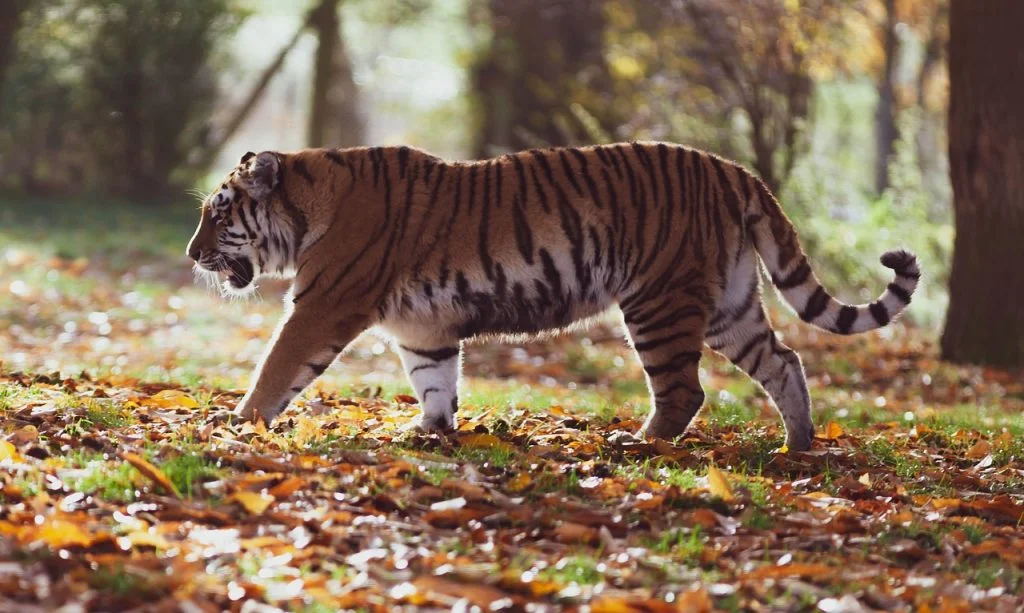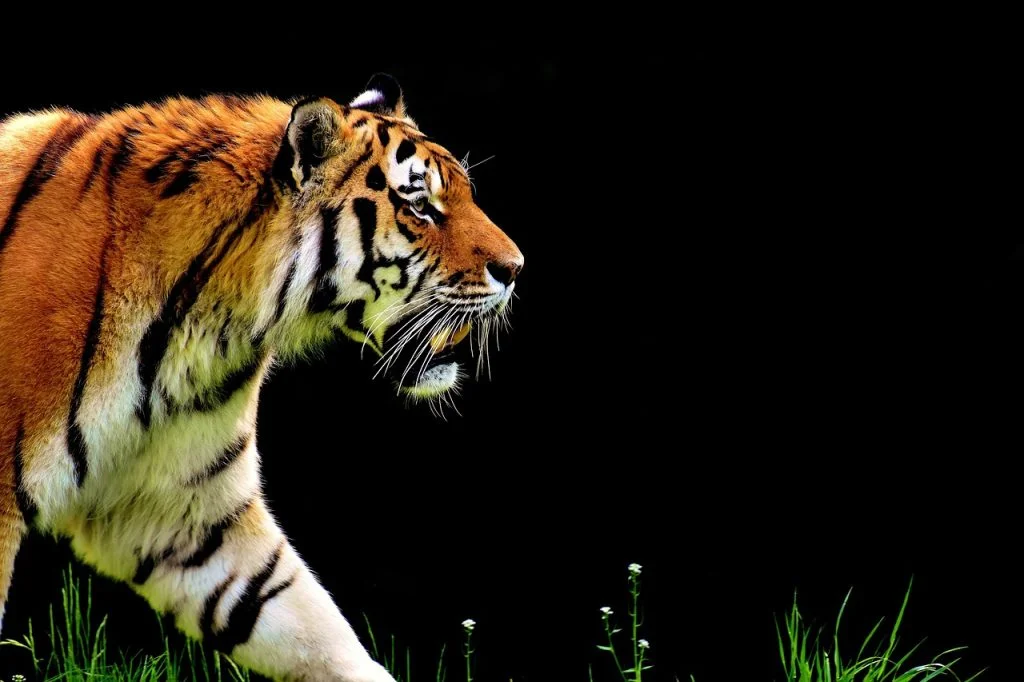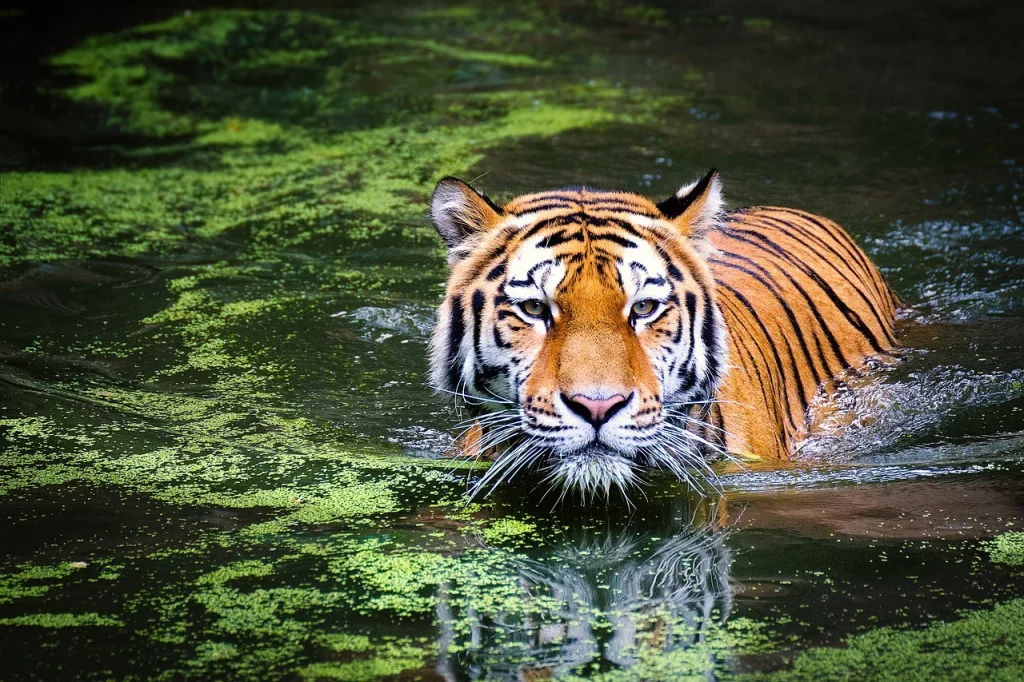Welcome to the jungle of knowledge, where we’re about to embark on a thrilling adventure into the world of tigers! Picture this: a creature so majestic that it could easily be the king of the catwalk in the animal kingdom.
Now, I’m not lion (sorry for this pun) when I say these facts will have you roaring with amazement. Did you know tigers are the largest of all wild cats? That’s right, even bigger than your fluffy Mr. Whiskers at home. And speaking of home, have you ever wondered where these striped wonders like to hang out?
Stick with me to uncover this and 49 more fur-tastic facts about tigers. But first, a quick question: have you ever seen a tiger do something utterly ridiculous? If not, prepare to be surprised!
The tiger will see you a hundred times before you see him once.
John Vaillant
Tiger Facts
Welcome to the world of tigers, where every stripe tells a story. Dive into these fascinating facts, and don’t forget there’s a quiz waiting at the bottom of the page, so read carefully if you want to be called a tiger master!
- Tigers are the largest naturally occurring species of cat.
- An adult Amur tiger can weigh up to 660 pounds.
- Tigers have a memory comparable to elephants.
- Each tiger’s stripes are unique, like human fingerprints.
- Bengal tigers are the most numerous subspecies.
- A group of tigers is called a “streak” or an “ambush”.
- Tigers can reach speeds of up to 40 mph.
- Their roar can be heard up to 2 miles away.
- Tigers are solitary creatures and fiercely territorial.
- They can leap distances of over 6 meters.
- A tiger’s night vision is six times better than that of humans.
- White tigers are not a separate species; they’re Bengal tigers with a genetic mutation.
- Tigers can swim well and often bathe in ponds and lakes.

- Cubs are born blind and only open their eyes after a week.
- Sumatran tigers are the smallest subspecies.
- Tigers have been known to imitate the call of other animals to lure prey.
- They can consume up to 90 pounds of meat in one meal.
- South China tigers are critically endangered, with few left in the wild.
- Three tiger subspecies have already become extinct.
- Mother tigers nurture their cubs for two to three years.
- Tigers mainly hunt large ungulates like deer and wild boar.
- Their whiskers help them navigate in the dark.
- Siberian tigers have the thickest fur among all tiger subspecies.
- Tigers mark their territory with urine and scent markings.
- They have loose skin on their belly, which protects them during fights.
- Tigers can live up to 15 years in the wild.
- In captivity, they can live up to 20 years or more.
- Tigers’ canines are the longest among all living felids.

- Global tiger population has fallen by over 95% in the past century.
- Indochinese tigers are isolated in small pockets of their former range.
- Malayan tigers were only classified as a separate subspecies in 2004.
- Tigers have over 100 stripes on their body.
- They are top predators in their ecosystems.
- Global warming and sea level rise threaten the Bengal tiger’s habitat.
- The illegal wildlife trade is a major threat to tigers.
- Tigers’ paws are designed for silent stalking.
- Tigers use their tails for balance when making sharp turns in pursuit of prey.
- Black tigers have denser stripes and are extremely rare.

- Only about 1 in 10 tiger hunts are successful.
- Tigers have a gestation period of about 3.5 months.
- Conservation efforts have seen tiger populations rebound in some areas.
- Tigers’ roar is used as a communication tool to assert dominance or find mates.
- Tigers can climb trees but are not as adept as leopards.
- Climate change impacts tigers by altering their habitats and prey availability.
- Habitat destruction is a significant threat to tiger populations.
- Poaching for fur and body parts is a major cause of the decline in tiger numbers.
- Tigers in captivity often face psychological issues due to confined spaces.
- Conservation programs include anti-poaching measures and habitat restoration.
- Community involvement is crucial in successful tiger conservation efforts.
- Tigers are apex predators, playing a crucial role in maintaining ecosystem balance.
Tiger Myths

I hope you enjoyed all these cool facts about tigers. Now it’s time to reveal the actual truth behind some common myths about these huge “cats” of the jungle.
- Tigers Are Man-Eaters by Nature
They generally avoid humans and only attack in self-defense or when they cannot hunt their natural prey. Encounters are rare and often exaggerated. - All Tigers Have the Same Stripes
Just like human fingerprints, every tiger has a unique stripe pattern. This uniqueness helps researchers in identifying and tracking individual tigers in the wild. - Tigers Can’t Climb Trees
While not as adept as leopards, some tigers, especially the younger ones, can climb trees. They usually do this to escape threats or to hunt. - Tigers Love to Live in Hot Climates Only
Tigers are adaptable and can live in various habitats, including the snowy regions of Siberia. The Siberian tiger is well adapted to cold climates. - Tigers Have a Roaring Appetite Every Day
They don’t need to eat every day. They can consume up to 40kg of meat at once and then go without food for several days. Their eating habits depend on the availability of prey.
No products found.
Tiger Quotes

We continue our journey with my favorite quotes about tigers. Let me know your favorite one in the comments section.
In me the tiger sniffs the rose.
Siegfried Sassoon
Siegfried Sassoon, a renowned poet, uses this line to symbolize the coexistence of ferocity and beauty within an individual or nature.
The impact of an attacking tiger can be compared to that of a piano falling on you from a second story window.
John Vaillant
Another striking quote by John Vaillant, illustrating the sheer power and force of a tiger’s attack with a vivid and startling comparison.
When a man wants to murder a tiger, it’s called sport; when the tiger wants to murder him, it’s called ferocity.
George Bernard Shaw
This quote from playwright George Bernard Shaw offers a critical view of hunting and the double standards for perceiving animal and human aggression.
I am sometimes a fox and sometimes a lion. The whole secret of government lies in knowing when to be the one or the other.
Napoleon Bonaparte
While not directly about tigers, Napoleon Bonaparte’s quote metaphorically uses animals, including the lion which is often likened to a tiger, to describe the duality of leadership traits.
Do not try to fight a lion if you are not one yourself.
African proverb
This African proverb uses the lion, often comparable to a tiger in its symbolism, to impart wisdom about recognizing and respecting the strengths of formidable opponents.
Tiger FAQ

Now that you have finished reading my collection of quotes, it is time for the final section before the quiz. Read carefully these frequently asked questions because they are the last piece of information that you are about to use.
- Are tigers endangered?
Yes, sadly, tigers are considered endangered. Various species of tigers are facing different levels of threat, primarily due to habitat loss, poaching, and conflicts with humans. Efforts are being made worldwide to protect these magnificent creatures and their habitats. - Can tigers climb trees?
While it’s not common, tigers can climb trees, especially when they are younger and lighter. Their powerful bodies are more suited to the ground, but in certain situations, like avoiding danger or pursuing prey, they might take to the trees. - What do tigers eat?
Tigers are carnivores, and they primarily feed on large prey like deer, wild boar, and buffalo. They are skilled hunters, using their stealth and power to take down prey. They can also eat smaller animals if larger prey is scarce. - Are tigers stronger than lions?
This is a topic often debated! Tigers are generally larger and more muscular than lions, which suggests they might be stronger. However, lions have their own strengths, like social hunting strategies. It’s hard to declare a definitive winner in this strength comparison. - Can tigers purr?
Tigers, unlike domestic cats, cannot purr in the same continuous way. They can make a unique sound similar to purring when they exhale, but they can’t maintain the sound like house cats do. This difference is due to variations in the structure of the larynx across different feline species.
No products found.
Tiger Quiz

It’s Tiger quiz Time! Answer these questions correctly, or you might just turn into the next tiger-striped mascot. And trust me, the costume is not as comfortable as it looks!
Conclusion
Concluding our exploration of tigers, we find ourselves deeply connected to these extraordinary animals. Tigers, in all their majestic splendor, are not just important characters in our myths and legends, but vital components of our natural world.
Their struggle for survival mirrors the broader challenges facing our planet. As you ponder their plight, consider this: What role can we play in safeguarding the future of tigers? Your voice and actions can be powerful tools for change. Let me know your ideas in the comments.
3 Sources Used For This ArticleLook Into The Eyes Of The Tiger – Wild Trails
87 Tiger Quotes And Famous Sayings About Tigers – Trvst


